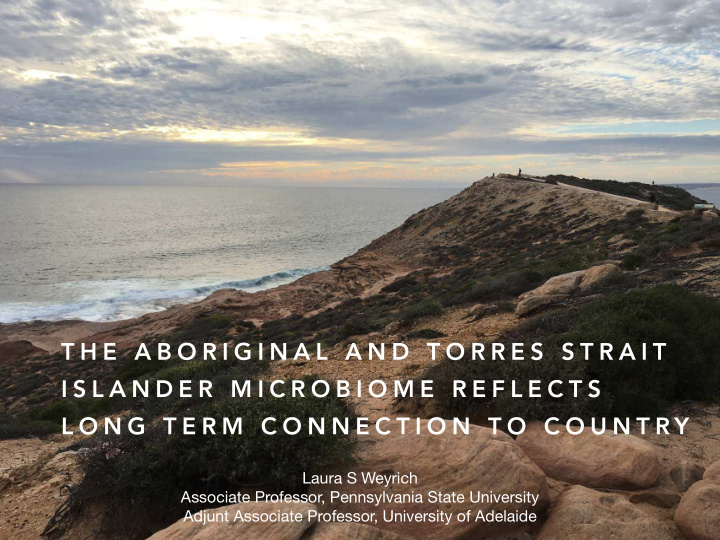



T H E A B O R I G I N A L A N D T O R R E S S T R A I T I S L A N D E R M I C R O B I O M E R E F L E C T S L O N G T E R M C O N N E C T I O N T O C O U N T R Y Laura S Weyrich Associate Professor, Pennsylvania State University Adjunt Associate Professor, University of Adelaide
H U M A N H E A LT H M AY B E T I G H T LY L I N K E D T O O U R M I C R O B I A L H E A LT H Microbiota: the microorganisms (bacteria, fungi, viruses) that live in the body > 50% of total cells; > 1,000 species; 1.4 kg of body weight Microbiome: the genetic and environmental content of the microbiota present in the body 2-5 million genes per individual; 99% of your genetic makeup! Open University
M I C R O B I O TA P L AY K E Y F U N C T I O N S Immune System Food Digestion Development OBESITY, Diabetes, Allergy, Malnutrition IBD, Eczema, Periodontal disease Vitamin Production Pregnancy Issues Infectious Disease Organ function Protection Salmonella or whooping cough Drug Metabolism Detoxify Dosage Effects Toxicity and Toxicity
E N V I R O N M E N T I M PA C T S T H E M I C R O B I O M E • Diet • Home • Job Industrial/European • Chemical Exposure • Human Interac9ons Traditional • Pets • Medical Treatment • Pollu9on • Seasonality • Hygiene hypothesis • Old Friends hypothesis • Biodiversity hypothesis • Widespread Antibiotic use
D R A S T I C C H A N G E S I N E N V I R O N M E N T I N A U S T R A L I A X 5 X 5 aihw.gov.au
I M PA C T S O N H U M A N H E A LT H - I N D I G E N O U S P E O P L E S Aboriginal*Australian* Aboriginal Australian Bacteriodetes* European Descent Proteobacteria* European*Descent* • Increased diversity • Novel oral species (Endomicrobium) from environment Handsley-Davis, Kapellas, Hedges, Jamieson, and Weyrich. In Review.
Early Childhood Caries in Aboriginal and Torres Strait Children • >80% of children have 100% 90% active caries (cavities) 80% compared to <20% of 70% Relative Abundance 60% non-Indigenous Children 50% 40% • Identify microorganisms Actinomyces 30% Aggregatibacter Fusobacterium Granulicatella Haemophilus Leptotrichia 20% Neisseria linked to severe caries Oribacterium Porphyromonas Prevotella Rothia 10% Streptococcus Unverified Prevotella Unclassified Gemellaceae Veillonella 0% Other genera <1% sequences 65 76 142 240 292 331 354 15 22 27 60 62 64 81 90 95 118 125 130 146 184 211 222 256 296 316 359 393 34 55 220 271 291 326 48 120 133 135 152 158 185 192 225 272 309 337 459 631 28 58 134 147 150 153 157 165 166 169 171 172 179 181 198 199 205 212 218 223 231 232 236 237 245 246 266 281 288 297 298 332 335 343 349 355 358 381 412 424 436 602 607 189 193 194 195 276 286 294 348 405 421 601 614 Control Group • Caucasian children = Streptococcus mutans Saliva Samples • Indigenous children = Lactobacillus salivarus, L. reuteri, Prevotella multisaccharivorax, and Mitsuokella HMT • Two species linked to periodontal disease in adults Skelly, et al. In Review.
How do we ‘rewild’ our microbiomes? • No one knows for sure… • Dietary change • High fiber diet? • Fermented foods? TheHealthCultur • Acids? • Environmental exposure • Birth? • Outdoor activity? • Animal exposure? • Farms? or Hay Mills, et al., 2016 Exposure?
T H A N K Y O U ! l s w 1 3 2 @ p s u . e d u @ l s w e y r i c h
Recommend
More recommend